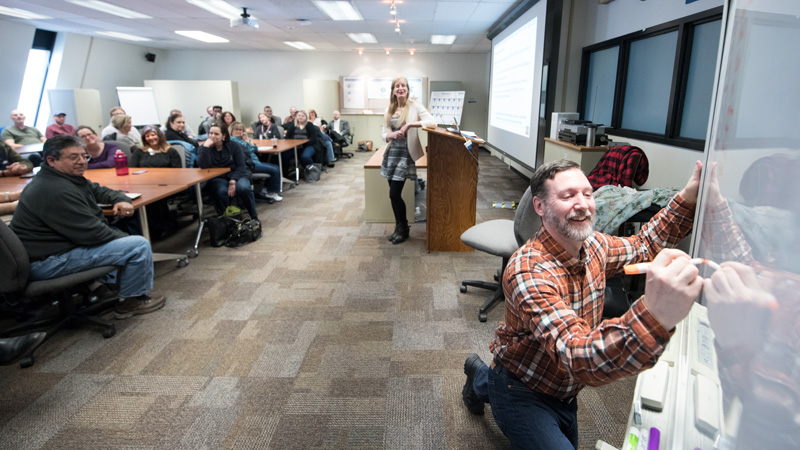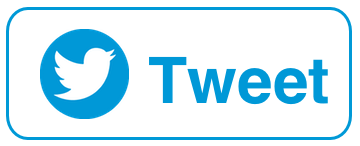Science thrives from a variety of perspectives and approaches. To support a more inclusive and diverse laboratory, Fermilab is hosting “Inclusion Matters”: a series of presentations designed to share information, challenge assumptions and supply tools for change.
The series includes an LGBTQ+ Safe Zone workshop from Fermilab’s own lab resource group for the LGBTQ+ community and allies, Spectrum. The trainings introduce terminology related to the LGBTQ+ community, address some of the challenges still present in the workplace, and provide tools for those who want to advocate for and support their LGBTQ+ colleagues (or themselves).
As part of the lab’s pride month celebration and in advance of the international LGBTSTEM Day on July 5, the workshop’s co-presenters Erica Snider and Pete Cholewinski shared their experiences on the team that developed the presentation, the response from the Fermilab community and what you can do to make workplaces more inclusive.
What was it like developing this training?
Erica Snider: Something that we brought to this particular training that is really relevant to Fermilab — and that we haven’t seen in other versions — is the bit we included on the science of biological sex. It connected to what we do as a science lab, and to me as a scientist as well. People often come in thinking that XX and XY is all there is. I remember seeing a bus driving around the country that had plastered on the side, “XX = girl, XY = boy, it’s biology.” That kind of antitransgender message was driving around the country, but the notion that the biology is that simple is completely wrong. I thought it was important to be able to show that the biology is actually very complicated, and you can expect the rest of sexuality to be complicated as well. And we should acknowledge and embrace that.
Pete Cholewinski: For our community, the science was very important. With sexuality or gender identity, people think it’s all in your head or your choice — and the science allowed us to ground it in a way that took it out of that rabbit hole. It allowed us to put everything on an objective platform. When we passed the presentation by the Out Alliance, they said they had never seen anything like that included and thought that it was absolutely wonderful. The response has been really tremendous. It was an eye opener for people to talk through the scientific data and all the information you get in that kind of discussion.

At a workshop, Fermilab’s Erica Snider, at lectern, and Pete Cholewinski, at whiteboard, discuss how the laboratory community can be more LGBTQ+ inclusive. Photo: Reidar Hahn
Can you say a bit more about how people have reacted to the trainings?
PC: Part of what we did is make sure there were some interactive discussions in this. People are laughing and talking to each other, and we can sense that people are engaged and enjoying themselves. We’ve gotten a lot of great questions. If you get to Q&A and you have no questions, you’ve failed. If you haven’t engaged them enough to want to challenge you or ask or say you’re wrong, you’ve missed the mark. But we’re getting questions, and a lot of people come up after and talk about their thoughts and reactions. It’s been really strong and positive.
ES: There’s been a lot of sharing during the sessions too. A lot of personal stories are being told. They see us up there sharing our stories, and they clearly feel safe to do that in the space of the class.
How did you feel about giving the presentations?
ES: I was pretty nervous about rolling it out. I was confident about the science section in the middle, because I understood it and it was indisputably factual. But I was nervous about how it would be received and go over. I think a lot of the success falls to the fact that we can present it in this really engaging way. So I’ve been surprised and pleased by the reception in general.
PC: It had been a while since I was active in a visible way in our community. At first, it was really uncomfortable to start talking about this at work and talking to people who were not part of my community. While creating it, I felt like I was slowly opening up again to the idea that I have something valuable to share and that it should be shared. By the time we got it done, I had no doubt it would be successful — but I did not expect the kind of positivity and interactions we’ve been able to generate. I expected polite listening, clapping, and the end. It hasn’t been like that at all. People that come to this, I feel they’ve gotten something that they didn’t know before. We’re stepping outside the message of “this is our community and this is how you should support us.” It’s career-focused: This is how community and work are changing; this is how you attract and retain the best talent; this is how you get diverse talent. This is resonating with people and broadening the relevance of the message we’re providing.
Why did you feel it was important to have this initiative at Fermilab?
ES: Because inclusion matters. Diversity improves our science, but you will never get diversity without inclusion. I remember what it was like here in the ‘80s and ‘90s, and 2000s, even. I saw a lot of people who left the field because it was so difficult to get along and fit in. It was like there was a particular mold for what a physicist had to look like. That’s been the worst thing ever for the field, because there are a lot of ways to be a great physicist, and we’ve lost great physicists because people didn’t want to fit that mold. A lot of the push for inclusion is really a push in that direction. There’s more than one way. There’s a lot of perspectives we need to bring to bear in solving the problems we need to solve. There’s a lot of dimensions to diversity, and it includes all underrepresented and often marginalized identities. It’s expanding the notion of what it takes to be a good physicist. And you can take those same principles and apply them to everything we do at the lab to make the physics happen.
PC: Even though I’m gay, I’m white and male and cis[gender], so I have a lot of dominant culture. When people assume that I am straight, I hear the kind of comments that people make when white straight males think no one else is around. Even if you aren’t contributing actively to discrimination, it still exists. You may not see it every day, or it may not affect you. But we do have a rather homogeneous group of people working here. It’s changing, but to make sure it keeps changing and it’s positive, people have to be aware of these issues.
What is your key takeaway message for those that attend the workshop?
ES: For me, it’s that we do our best work when we work together. The way that we can work together is to be respectful of each other.
PC: We all have biases, but when you come to work, you have to treat people with respect in spite of them. It’s not a PC thing or that you can’t speak, it’s just about treating people the way you would want to be treated. It can open up your own experience to different kinds of people and perspectives. It makes life more interesting to be that way, rather than just talking to people who fall within a narrow range of human existence.
What changes, little or big, do you hope people will make in their workplaces, whether at Fermilab or elsewhere?
ES: Anyone who goes to this kind of training, make sure to practice what you’re learning. It doesn’t mean you have to go join pride parades, but when you see discrimination, don’t be silent about it. Do small things. Try to engage people in the conversation. Spread the message so it’s not something you go to once and then go back to the way things were.
What does Spectrum have planned next?
PC: We have one more safe zone training in the Inclusion Matters series in August. But the next question is how to continue. After the next one, we don’t want it to end.
ES: I think the fact that Pete and I were so involved in the development of the slide deck, we can really own all the words. As someone who gives lots of presentations, I know the importance of owning the words and slides. Even if Pete and I want to do this for a long time, there need to be other people who will do this. And we need to give those people the freedom to change the presentation to suit their own voice. That’s part of being inclusive.



